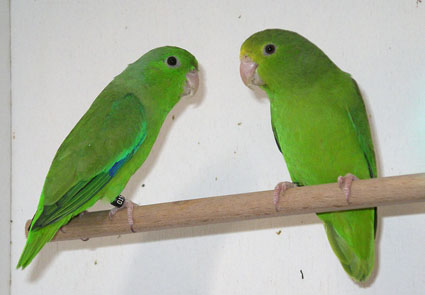
Green-rumped parrotlet(Forpus passerinus)
Phylum —chordata
Class — aves
Order — psittaciformes
Family —psittacidae
Genus – forpus
Appearance
The male is mainly emerald-green in coloration, over the forehead and cheeks, with a grayish suffusion to the nape and hindneck. The underparts are also emerald-green, as is the lower back and rump, although pale blue suffusion may be apparent on the green of the lower back. The bend of the wing and the carpal edge are blue. Both the under wing-coverts and the primary coverts are violet-blue, with the secondaries (shorter, upper "arm" feathers) being a paler shade of blue. The lower surface of the flight feathers is bluish green, while the tail feathers are entirely green, but of a paler shade underneath. The beak is whitish pink and the legs are pinkish. The eyes (irises) are dark brown.
Hens can be distinguished easily because they lack the blue plumage evident in cocks. The forehead is also more brightly colored, being a strong shade of yellowish green.
Young birds resemble adults in appearance.
The Green-rumped parrotlet has several subspecies, which differ in plumage color, with mainly green plumage overall, but with some variations on the blue wing feathers, and more or less pale underparts.
Length – 12-13 cm, weight – 20-28 g.
Habitat
The Green-rumped parrotlet lives in northern South America, in tropical areas. It breeds from Colombia, Venezuela and Trinidad, to Guianas and Brazil.
Behavior
Green-rumped parrotlets are very gregarious and roost communally; they are often seen in flocks of up to 100 individuals.
Green-rumped parrotlets make light, twittering calls. While in flocks, calls are louder and more penetrating. Contact calls, similar to names, are individually distinct and are used for individual mate recognition. Each call varies in duration, frequency, and pitch.
The Green-rumped parrotlet is resident in its range, only performing some movements for food, or seasonal and altitudinal movements.
Diet
The Green-rumped parrotlet feeds mainly on seeds from grass and weeds, small berries and fruits. It also consumes leaf buds and blossoms.
Reproduction
The breeding season varies according to the geographic range. The Green-rumped parrotlet nests in cavities, hollows in tree trunks, limbs and stumps, and sometimes in arboreal termitarium.Female lays about 5 white eggs. Incubation lasts about two weeks, mainly by female. The male feeds her during this period.The nesting period lasts 4 to 5 weeks. About half of the females have a second clutch in wild.
In captivity
The parrotlet has an average of around 20 years, but it can easily make it to 30 years with a nutritious diet and regular activity.
Although Green-rumped parrotlets are tiny, they are highly vigorous creatures, and therefore need roomy cage environments – a minimum of 4 feet long. Look for a cage that is made out of a sturdy and tough material such as wrought iron. For safety purposes, make sure the bars are not far away from each other. That way, your parrotlet can't poke out his curious head. Do not allow over half an inch of distance between all of the individual bars.
Toys are crucial for keeping Green-rumped parrotlets happy and occupied. Ample chew toys are a must. Just check with the veterinarian first to make sure that the toys are always made out of safe substances, like pine. If your parrotlet has things to chew, he can remain busy and content even when you're not at home. Make a point to routinely switch out the toys in the cage, as you don't want to run the risk of your bird tiring of anything due to overexposure. To manage his feet, several perches are also vital. Provide variety your bird's perches, with varying shapes and forms including everything from rectangles to tree limbs.
Although Green-rumped parrotlets are small in size, they make up for it with their bold personalities – sometimes to the point that they can even be rather fierce. Prevent unnecessary – and potentially dangerous – physical incidents by always having your parrotlet living on his own – sans cage mates.
Encourage restful sleep in your Green-rumped parrotlet by giving him a calm, dark and quiet space to sleep every night. Make sure that he can receive a minimum of 10 or so uninterrupted hours.
One of the biggest parts of caring for Green-rumped parrotlets is proper diet. These companion birds, like a lot of other bird species, require "menus" that are centered around commercial pellets. Allow your Green-rumped parrotlet to have constant access to pellets. Apart from pellets, diced fresh fruits and vegetables are also important for these birds. Some parrotlet-friendly fruits and vegetables are corn, bananas, oranges, carrots, pears, apples, peas, celery, pomegranates, green beans and kiwi. Allow tiny portions of nuts and seeds – but never more often than one serving per day. Dietary supplementation for calcium is also crucial. Cuttlebones, which are cuttlefish shells, are suitable for these purposes. Always speak with an avian veterinarian before you allow your parrotlet to eat any foods, whether vegetables, fruits, seeds or anything else.
 Russian
Russian
 English
English























